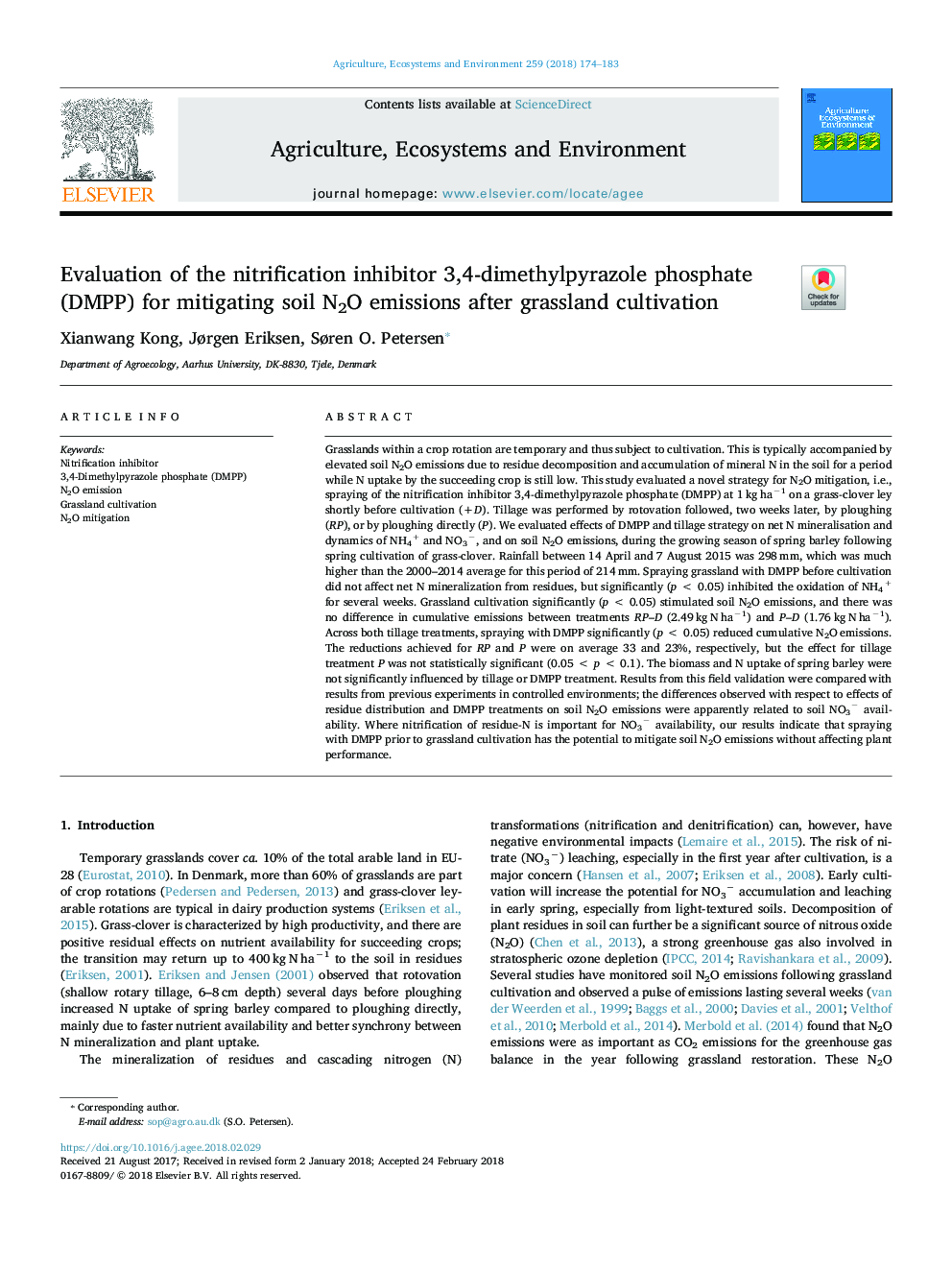| کد مقاله | کد نشریه | سال انتشار | مقاله انگلیسی | نسخه تمام متن |
|---|---|---|---|---|
| 8487107 | 1551993 | 2018 | 10 صفحه PDF | دانلود رایگان |
عنوان انگلیسی مقاله ISI
Evaluation of the nitrification inhibitor 3,4-dimethylpyrazole phosphate (DMPP) for mitigating soil N2O emissions after grassland cultivation
دانلود مقاله + سفارش ترجمه
دانلود مقاله ISI انگلیسی
رایگان برای ایرانیان
موضوعات مرتبط
علوم زیستی و بیوفناوری
علوم کشاورزی و بیولوژیک
علوم زراعت و اصلاح نباتات
پیش نمایش صفحه اول مقاله

چکیده انگلیسی
Grasslands within a crop rotation are temporary and thus subject to cultivation. This is typically accompanied by elevated soil N2O emissions due to residue decomposition and accumulation of mineral N in the soil for a period while N uptake by the succeeding crop is still low. This study evaluated a novel strategy for N2O mitigation, i.e., spraying of the nitrification inhibitor 3,4-dimethylpyrazole phosphate (DMPP) at 1â¯kgâ¯haâ1 on a grass-clover ley shortly before cultivation (+D). Tillage was performed by rotovation followed, two weeks later, by ploughing (RP), or by ploughing directly (P). We evaluated effects of DMPP and tillage strategy on net N mineralisation and dynamics of NH4+ and NO3â, and on soil N2O emissions, during the growing season of spring barley following spring cultivation of grass-clover. Rainfall between 14 April and 7 August 2015 was 298â¯mm, which was much higher than the 2000-2014 average for this period of 214â¯mm. Spraying grassland with DMPP before cultivation did not affect net N mineralization from residues, but significantly (pâ¯<â¯0.05) inhibited the oxidation of NH4+ for several weeks. Grassland cultivation significantly (pâ¯<â¯0.05) stimulated soil N2O emissions, and there was no difference in cumulative emissions between treatments RP-D (2.49â¯kgâ¯Nâ¯haâ1) and P-D (1.76â¯kgâ¯Nâ¯haâ1). Across both tillage treatments, spraying with DMPP significantly (pâ¯<â¯0.05) reduced cumulative N2O emissions. The reductions achieved for RP and P were on average 33 and 23%, respectively, but the effect for tillage treatment P was not statistically significant (0.05â¯<â¯pâ¯<â¯0.1). The biomass and N uptake of spring barley were not significantly influenced by tillage or DMPP treatment. Results from this field validation were compared with results from previous experiments in controlled environments; the differences observed with respect to effects of residue distribution and DMPP treatments on soil N2O emissions were apparently related to soil NO3â availability. Where nitrification of residue-N is important for NO3â availability, our results indicate that spraying with DMPP prior to grassland cultivation has the potential to mitigate soil N2O emissions without affecting plant performance.
ناشر
Database: Elsevier - ScienceDirect (ساینس دایرکت)
Journal: Agriculture, Ecosystems & Environment - Volume 259, 1 May 2018, Pages 174-183
Journal: Agriculture, Ecosystems & Environment - Volume 259, 1 May 2018, Pages 174-183
نویسندگان
Xianwang Kong, Jørgen Eriksen, Søren O. Petersen,